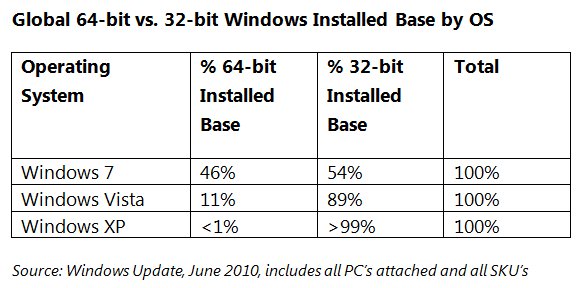It should come as little surprise that the 64-bit edition of Windows 7 has become so popular. With the price of RAM plummeting over the last few years, even low-end systems will often come with three or four gigabytes worth. Of course, this will run afoul of the 4GB limit found on 32-bit systems, which will limit the usable amount. While a 64-bit OS raises this limit to a theoretical ceiling of 17.2 exabytes (billion gigabytes), Windows 7 is limited to a ‘mere’ 192GB of RAM for most versions. Even the 16GB limit on the Home Premium edition should be more than most users will need at any time in the foreseeable future.

The numbers also show the relative popularity of the current 64-bit OS compared to Windows Vista. In the three-and-a-half years since it launched, only 11 percent of the installs of the older operating system were 64-bit. The manufacturer points to the high uptake by OEMs as the leading force of change. According to the report 77 percent of PCs sold at retail in the US during April of this year had Windows 7 64-bit pre-installed.
The increased popularity of 64-bit operating systems is definitely a positive sign. As well as support for more RAM, there are various security and performance benefits, especially as application developers begin to design their software to run natively in that environment. With such a large installed user base, this will become an increasingly viable option for many devs.













